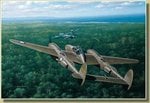- Thread starter
- #61
syscom3
Pacific Historian
In the Pacific, there wasnt any armor to shoot at. However, for the marines, lucky the Corsair could carry those big napalm tanks.
Anyone remember the pictures of them taking off at Peleliu (Palau Islands) and being so close to the Japanese positions, they didnt even have time to raise up their gear?
One other thing that we forget the P38 was famous for......... it was the "Get Yamamoto" mission. Absolutely perfect mission planning and execution of it, coupled with some fantastic navigation by the flight leader.
It couldnt have been done without the dependability of two engines and the range the P38 had.
http://p-38online.com/yam.html
Anyone remember the pictures of them taking off at Peleliu (Palau Islands) and being so close to the Japanese positions, they didnt even have time to raise up their gear?
One other thing that we forget the P38 was famous for......... it was the "Get Yamamoto" mission. Absolutely perfect mission planning and execution of it, coupled with some fantastic navigation by the flight leader.
It couldnt have been done without the dependability of two engines and the range the P38 had.
http://p-38online.com/yam.html


